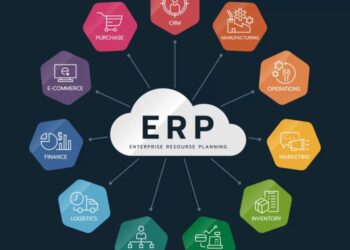In today's competitive business landscape, implementing an ERP system tailored for small businesses is crucial for streamlining operations and driving growth. This article delves into the realm of ERP for small business, shedding light on key considerations and best practices to maximize efficiency and productivity.
As we navigate through the intricacies of ERP systems for small businesses, we aim to provide valuable insights and practical guidance to help you make informed decisions for your business's future.
Introduction to ERP for Small Business

Enterprise Resource Planning (ERP) systems are integrated software solutions that help small businesses manage and streamline their day-to-day operations efficiently. These systems centralize data from various departments and automate processes, providing real-time insights and enhancing overall productivity.
Benefits of Implementing ERP Systems for Small Businesses
- Improved Efficiency: ERP systems automate repetitive tasks, reducing manual errors and saving time.
- Enhanced Data Accuracy: Centralized data storage ensures consistency and accuracy across departments.
- Better Decision-Making: Real-time insights enable small business owners to make informed decisions quickly.
- Cost Savings: By streamlining processes and reducing manual work, ERP systems help cut operational costs.
Common ERP Modules Used by Small Businesses
- Financial Management: Tracks finances, generates reports, and manages budgets.
- Inventory Management: Manages stock levels, tracks inventory movement, and optimizes supply chain.
- Customer Relationship Management (CRM): Manages customer interactions, sales, and marketing activities.
- Human Resources: Handles employee information, payroll, benefits, and performance evaluations.
Factors to Consider When Choosing an ERP System for Small Business
When selecting an ERP system for a small business, there are several key factors that need to be taken into consideration to ensure the system meets the specific needs and requirements of the business.
Importance of Scalability
Scalability is crucial when choosing an ERP system for a small business as it allows the system to grow and adapt along with the business. A scalable ERP system can accommodate an increase in users, transactions, and data volume without requiring a complete overhaul of the system.
This flexibility is essential for small businesses that are looking to expand and evolve over time.
Key Features to Look For
Small businesses should look for certain key features in an ERP system to ensure it effectively meets their needs. Some important features to consider include:
- Customization options to tailor the system to specific business processes
- Integration capabilities with other software applications used by the business
- Automated reporting and analytics for better decision-making
- User-friendly interface for easy adoption and training
- Mobile accessibility for remote access and flexibility
Cloud-based ERP Solutions vs. On-premise Solutions
When comparing cloud-based ERP solutions to on-premise solutions for small businesses, there are a few key differences to consider. Cloud-based ERP systems offer benefits such as lower upfront costs, automatic updates, and scalability, making them a popular choice for small businesses.
On the other hand, on-premise solutions provide greater control and customization options but require higher initial investments and ongoing maintenance costs. Small businesses should weigh the pros and cons of each type of system based on their specific needs and budget constraints.
Implementation of ERP Systems for Small Businesses
Implementing an ERP system in a small business can be a complex process, but with careful planning and execution, it can lead to significant improvements in operational efficiency and decision-making. Below is a step-by-step guide on how to successfully implement an ERP system in a small business.
Step-by-Step Guide to Implementing an ERP System
- Conduct a thorough needs assessment to identify the key requirements and goals of the business.
- Choose the right ERP system that aligns with the specific needs and budget constraints of the business.
- Develop a detailed implementation plan outlining the timeline, resources, and responsibilities of each team member.
- Customize the ERP system to meet the unique processes and workflows of the business.
- Migrate data from existing systems to the new ERP system, ensuring accuracy and consistency.
- Provide comprehensive training to employees on how to use the ERP system effectively.
- Monitor the implementation process closely and address any issues or concerns promptly.
- Regularly evaluate the performance of the ERP system and make necessary adjustments to optimize its functionality.
Common Challenges Faced During ERP Implementation for Small Businesses
- Lack of clear communication and alignment between stakeholders.
- Resistance to change from employees accustomed to old processes.
- Inadequate training leading to low user adoption rates.
- Data migration errors causing disruptions in daily operations.
- Overlooking the importance of ongoing support and maintenance.
Best Practices for Training Employees on Using the New ERP System
- Provide hands-on training sessions tailored to different user roles and responsibilities.
- Offer continuous support through help desks, online resources, and user guides.
- Encourage feedback from employees to identify areas for improvement and additional training.
- Utilize gamification and incentives to motivate employees to engage with the ERP system.
- Regularly assess the effectiveness of training programs and make adjustments as needed.
Cost Considerations for Small Businesses Implementing ERP
Implementing an ERP system can be a significant investment for small businesses. It is important to carefully consider the costs involved to ensure a successful implementation process.
Breakdown of Potential Costs
- Software Licensing Fees: Small businesses need to purchase licenses for the ERP software, which can vary based on the number of users and modules required.
- Implementation Costs: This includes expenses related to customization, data migration, training, and consulting services.
- Infrastructure Costs: Investments in hardware, servers, and network infrastructure may be necessary to support the ERP system.
- Maintenance and Support: Ongoing costs for system updates, maintenance, and technical support should be factored into the budget.
Ways to Optimize Costs
- Cloud-Based Solutions: Consider opting for cloud-based ERP systems to reduce the need for expensive hardware and infrastructure investments.
- Phased Implementation: Implementing the ERP system in phases can help spread out costs and minimize disruption to daily operations.
- Training and Support: Invest in training for employees to maximize system efficiency and reduce the need for external support services.
Return on Investment (ROI)
While implementing an ERP system may involve significant upfront costs, the long-term benefits can outweigh the initial investment. Increased efficiency, streamlined processes, improved decision-making, and enhanced scalability are some of the ways small businesses can experience a positive ROI from ERP implementation.
Ending Remarks
As we conclude our exploration of ERP for small business, it becomes evident that a well-planned ERP implementation can revolutionize the way small businesses operate. By embracing the right ERP solution and strategies, small businesses can unlock new levels of success and competitiveness in today's dynamic market landscape.
Q&A
How can ERP benefit small businesses?
ERP systems help small businesses integrate processes, improve data accuracy, enhance decision-making, and boost overall efficiency.
What should small businesses consider when choosing an ERP system?
Scalability, key features tailored for small businesses, and the choice between cloud-based and on-premise solutions are crucial factors to consider.
What are common challenges in implementing ERP systems for small businesses?
Common challenges include data migration issues, resistance to change among employees, and ensuring proper training for effective system utilization.
How can small businesses optimize costs during ERP implementation?
Optimizing costs involves careful planning, thorough research on pricing options, and leveraging available resources efficiently to minimize unnecessary expenses.
What is the typical ROI of implementing an ERP system for a small business?
The ROI of implementing an ERP system varies but often includes improved operational efficiency, reduced manual errors, and better decision-making capabilities, leading to long-term cost savings and business growth.







![Best Construction ERP Software [2024 Edition]](https://health.bandungnews.id/wp-content/uploads/2025/10/Top-10-Best-Construction-ERP-Software-to-Use-in-2024-1-120x86.jpg)



